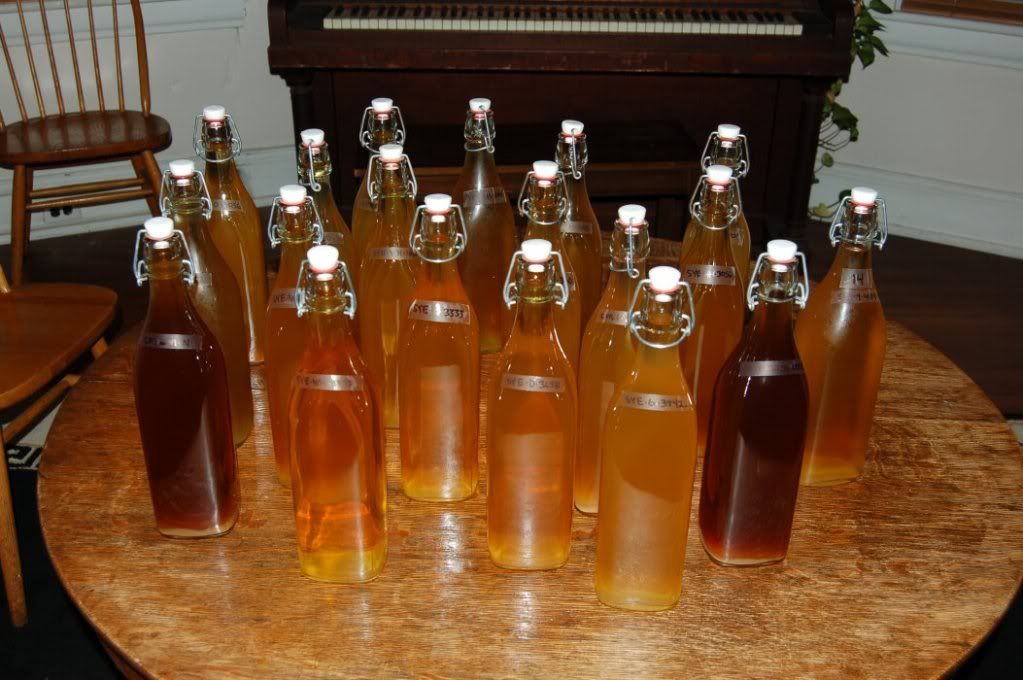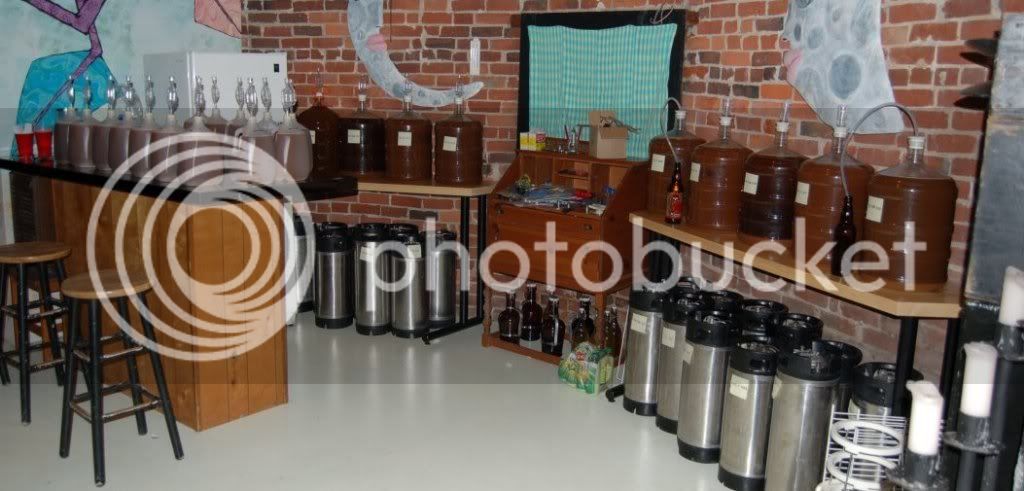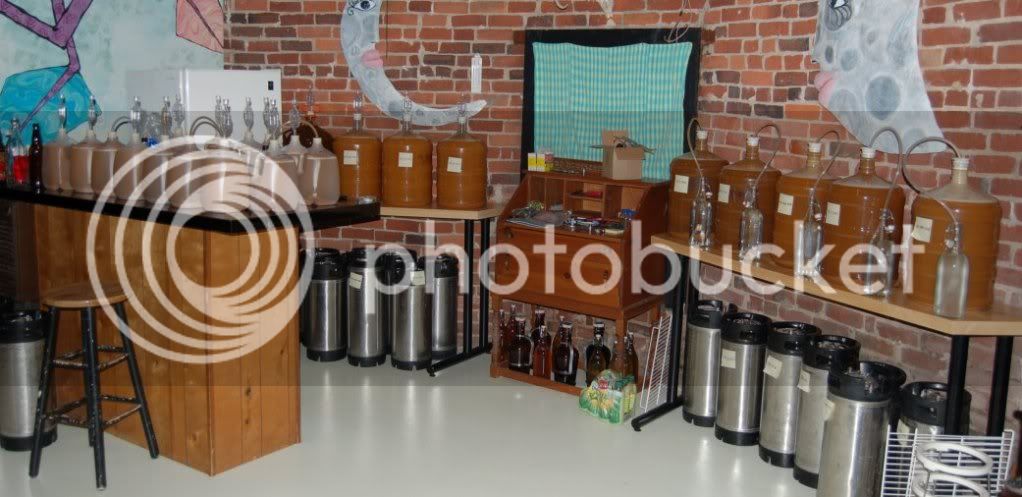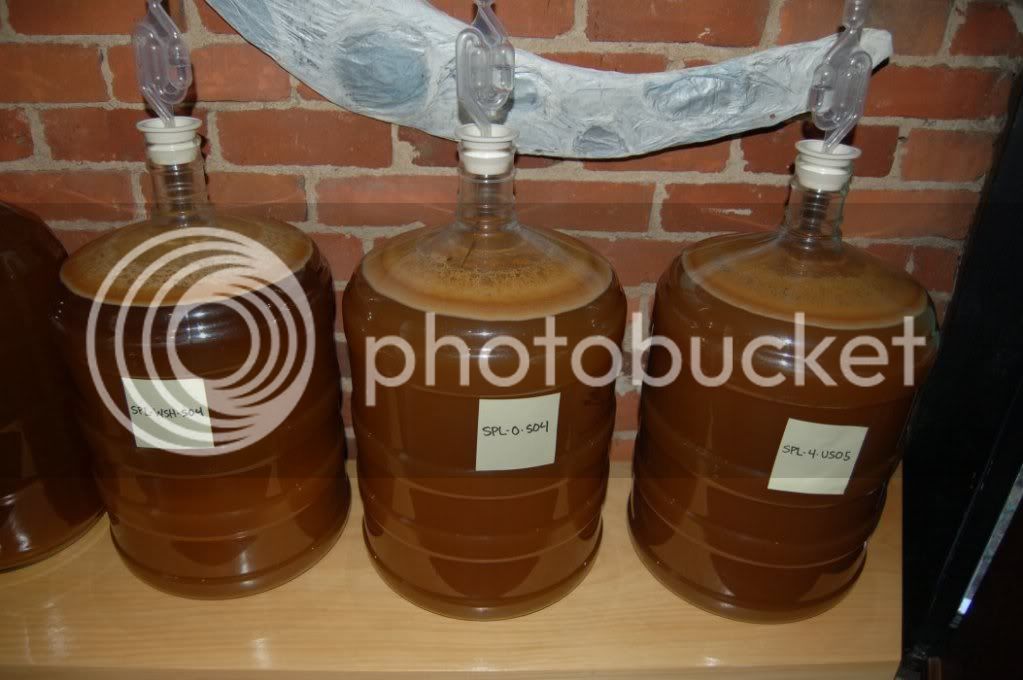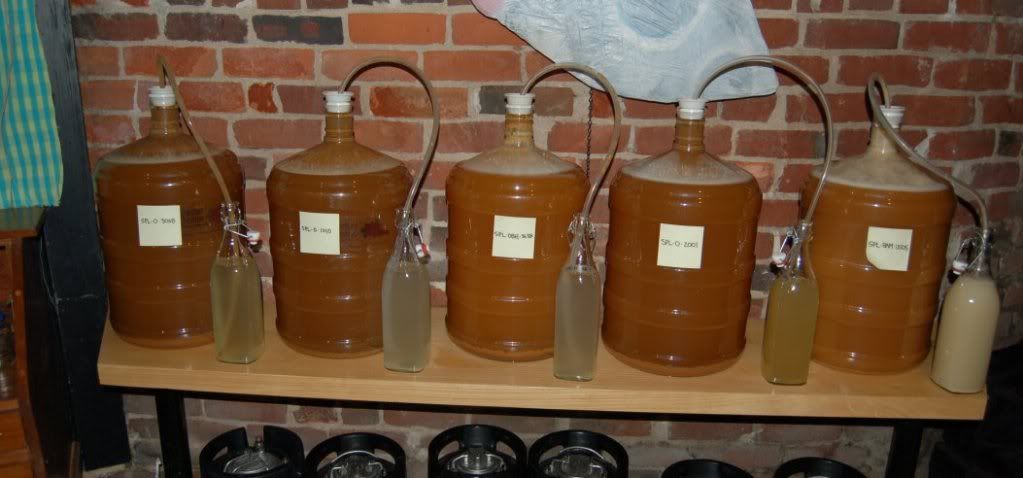The weekend before last, some friends came over to check out this seasons experimental batches. We checked out 4 DME batches, 13 wheat and pilsner yeast batches and 2 batches from last year, so 19 liters total on the menu, plus a few extras that we drank afterwards for good measure. It was a pretty good crowd and 19 folks were kind enough to fill out rating sheets. Overall, it was one of the best tastings so far.
The juice was mostly from two pressings this Fall: The first was a mix of Cortland, McIntosh, Gala, Jonathan, pressed on 9/14/09 with an OG 1.050 and pH 3.7. The second was a mix of Stayman, York and Empire, pressed 10/8/09 OG 1.054, pH 3.9. All batches were unpasteurized juice with no k-meta. Most were gallon batches, cold crashed and bottled right afterwards
Here are the ciders with (average scores rated 1-10, with 10 highest) and [overall ranking] for top five
DME batches all one gallon batches from the 9/14 pressing. All were cold crashed after 6 days of fermentation
(4.86) 6oz light malt, S04 ale yeast, fg 1.006
(4.69) 6oz dark malt, Nottingham ale yeast, fg 1.004
(6.91) 6oz light malt,, US05 ale yeast, fg 1.012
(6.09) 6oz dark malt, US05 ale yeast, fg 1.010
These 4 DME batches were the best of the 15 batches that I made. Of these, the US05 came out the best. The one with the light malt had a little bit of fizz, so the cold crash didnt completely stop that one. All of them were fairly cloudy. At this point the DME batches were about 6 weeks old and hopefully will continue to improve, although at this point, not much to write home about.
Wheat/Pilsner batches All of these were one gallon batches from the 10/8 pressing, except for the first one, which was a keg batch from the 9/14 pressing. This recipe is one of the regular crowd favorites, so I considered it the one to beat as far as the wheat yeast batches were concerned. The others were crashed to taste, from 6 to 21 days after pitching the yeast:
[2] (8.32) 24oz Turbinado, 12oz Dextrose (keg batch), Wyeast 3068 fg 1.026
[4] (8.21) No sugar. Wyeast 1010, fg 1.010
(6.68) 7 oz wildflower honey, Wyeast 3638, fg 1.010
[1] (8.38) No sugar. Wyeast 3056, fg 1.012
[5] (7.91) 4oz Turbinado, 2oz Dextrose. Wyeast 3333, fg 1.020
(6.91) 7 oz wildflower honey, WLP380, fg 1.008
(7.41) No sugar. Wyeast 3638, fg 1.012
(7.69) 4oz Turbinado, 2oz Dextrose. Wyeast 3942, fg 1.010
(6.56) 7 oz wildflower honey, Wyeast 3056, fg 1.004
(7.47) No sugar. Wyeast 2001, fg 1.012
[3] (8.28) 4oz Turbinado, 2oz Dextrose. WLP380, fg 1.014
(7.13) 7 oz wildflower honey, Wyeast 1010, fg 1.010
(7.36) 7 oz wildflower honey, Wyeast 3333, fg 1.018
The 3056 batch barely edged out the previous crowd favorite 3068, with the 1010 and WLP380 close behind. Its worth noting that the 3068 was keg carbonated while the others were still they probably would have scored higher if they had been carbonated.
The 12 wheat and pilsner batches were from a total of 21 test batches. During the World Series, a buddy and I sampled a grolsh of each and these 12 were the ones that made the first cut. The others may get a bit better with age.
None of the batches with honey scored very high, although there were a couple that I thought were pretty good (the 1010 and 3638). In retrospect I should have used an orange blossom honey instead of wildflower for the wheat yeast cisers. Wildflower works well with the ale yeasts but doesnt seem to fit the wheat yeasts very well.
The 3638 and 3333 wheat yeasts were the most clear, followed by the 3943, 3056 and 380, and then the rest. The 3333, 3942 and 2001 fermented the fastest, followed by 3056, then the 1010, 3638 and 380. The 380 took the longest to start fermenting and needed a blowoff tube. The 1010 also needed a blowoff tube
I liked the taste of the 2001 it was a little more distinctive than the others, but unfortunately it picked up some sulfur in the bottle, which depressed the score. This one stank a bit when it was fermenting it was the only one that did. At bottling time the smell had cleared up and it smelled and tasted great, but the sulfur smell came back after a couple weeks in the bottle. I think this one would have scored a lot higher if it had been a keg batch, because I could have scrubbed it. Ill probably do a keg batch with it later in the season, even though it didnt make the top 5.
The last two bottles in the tasting were some dry batches from last year. These were both keg batches:
(7.08) York and Fuji apples, Pressed 1/5/09, 1 ½ lb Basswood and 1 ½ lb Clover honey, S04 ale yeast, fg 1.002
(6.08) Stayman and Winesap apples, Pressed 10/30/08, 1 lb Turbinado ½ lb Dextrose, Wyeast 4184 meade yeast,
Both have improved since last summer and got better scores. As dry ciders go, they were great. They got a lot of 9s and 10s from a few folks who like dry ciders, but the majority of folks didnt care much for them and they didnt even get close to breaking into the top 5
Ill be getting more juice in another week and will definitely make some more keg batches with a few of these wheat yeasts. As far as experimental batches go, I got 8 different dry yeasts that I ordered from the UK which arent available in the US, so Ill be checking those out, along with some other dry yeasts.








![Craft A Brew - Safale BE-256 Yeast - Fermentis - Belgian Ale Dry Yeast - For Belgian & Strong Ales - Ingredients for Home Brewing - Beer Making Supplies - [3 Pack]](https://m.media-amazon.com/images/I/51bcKEwQmWL._SL500_.jpg)







































